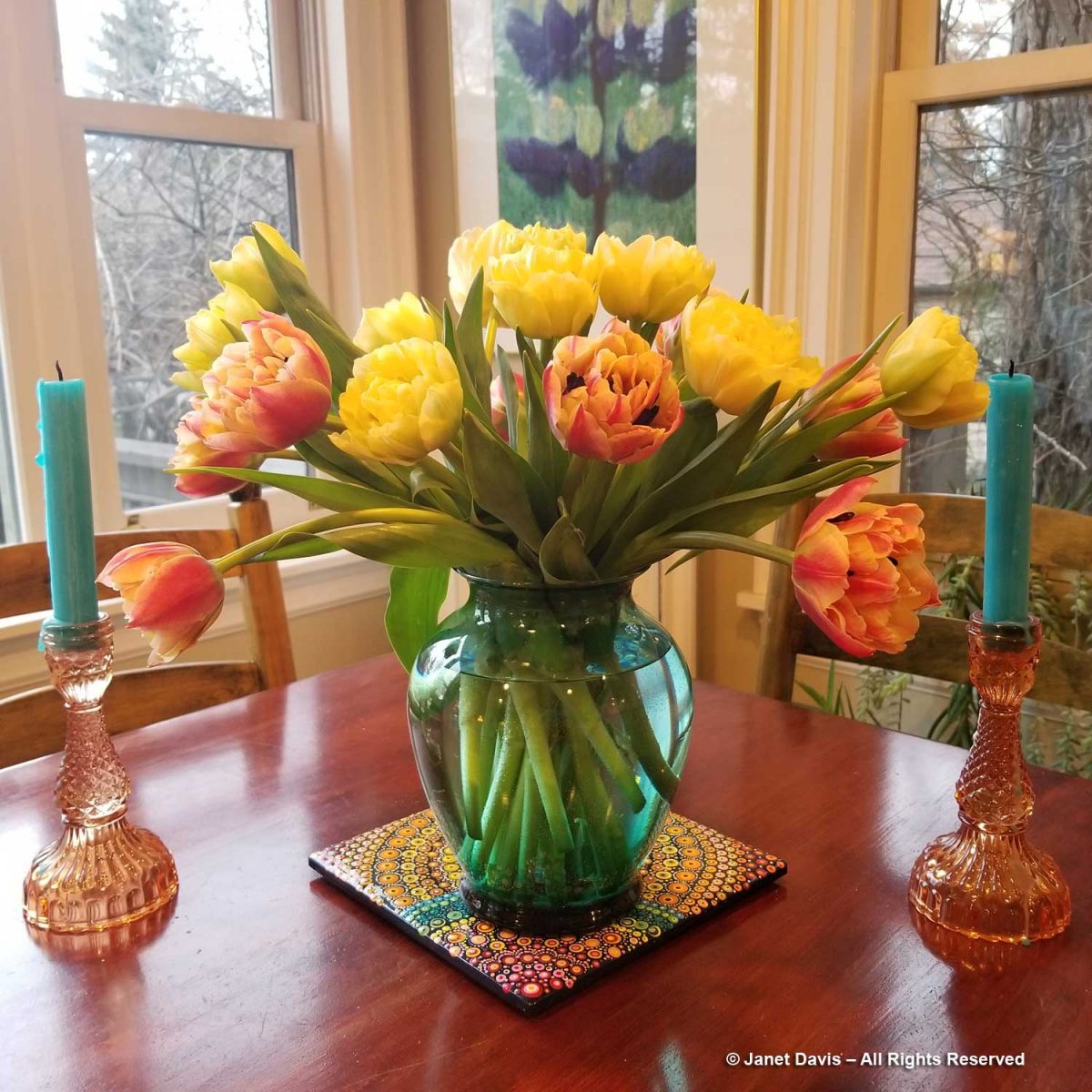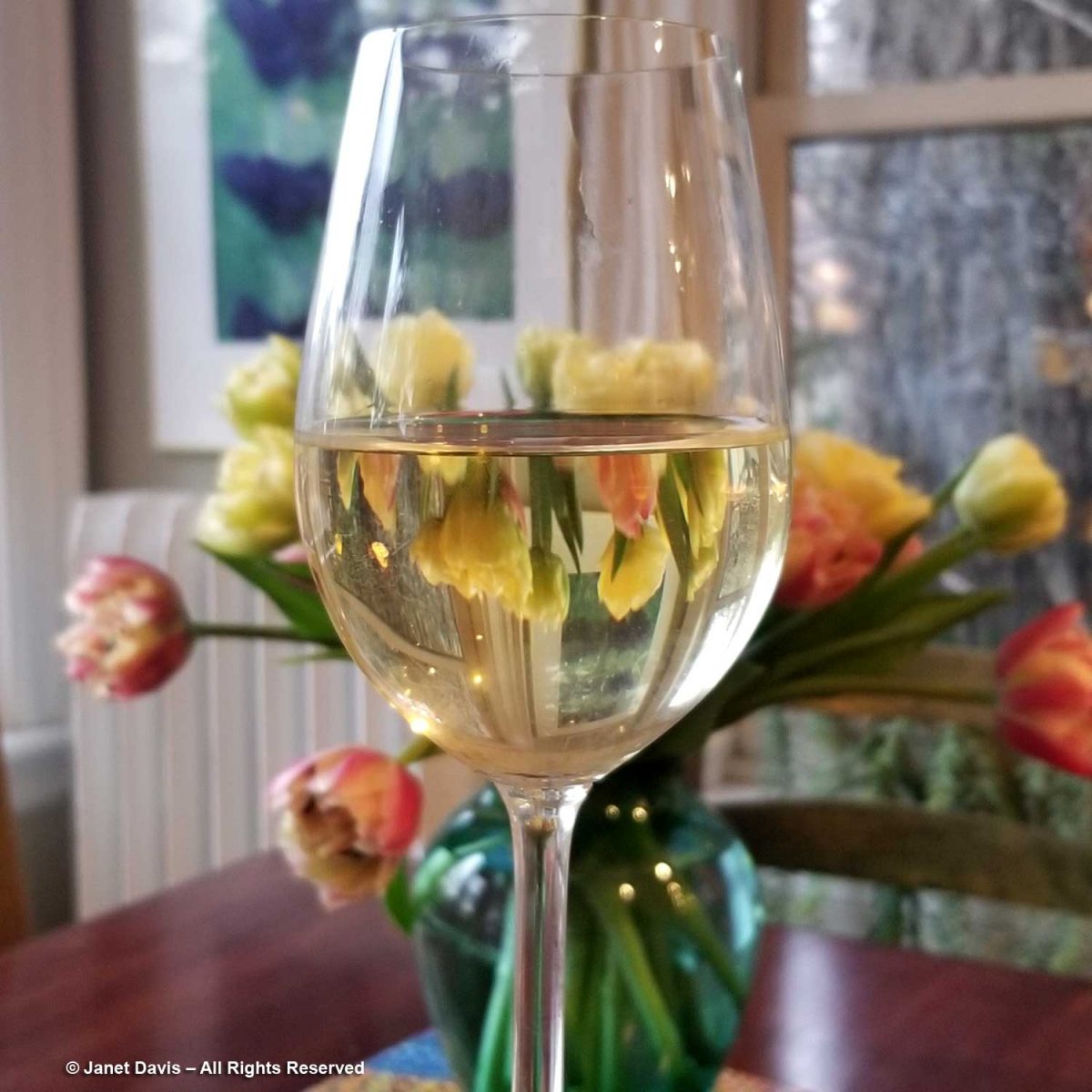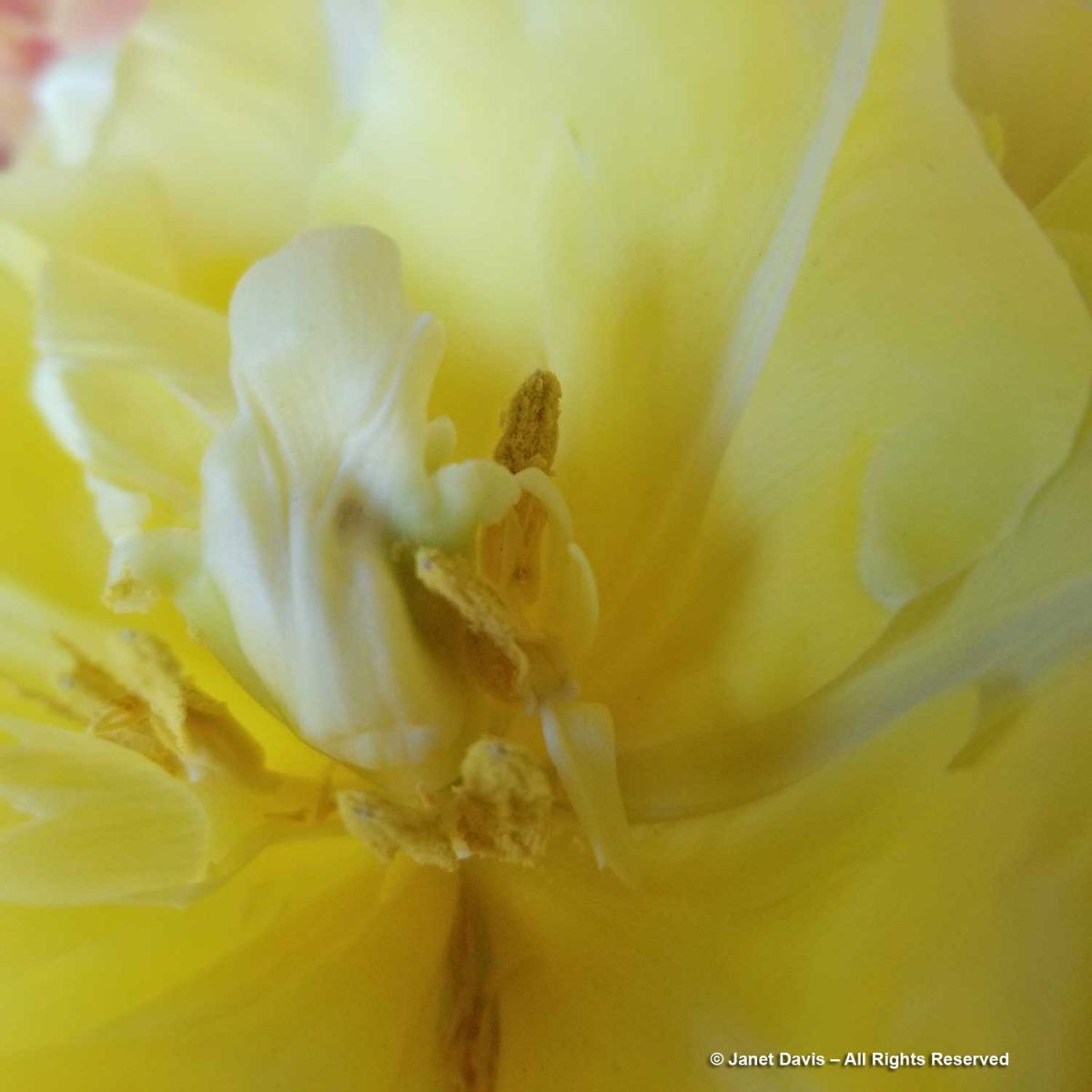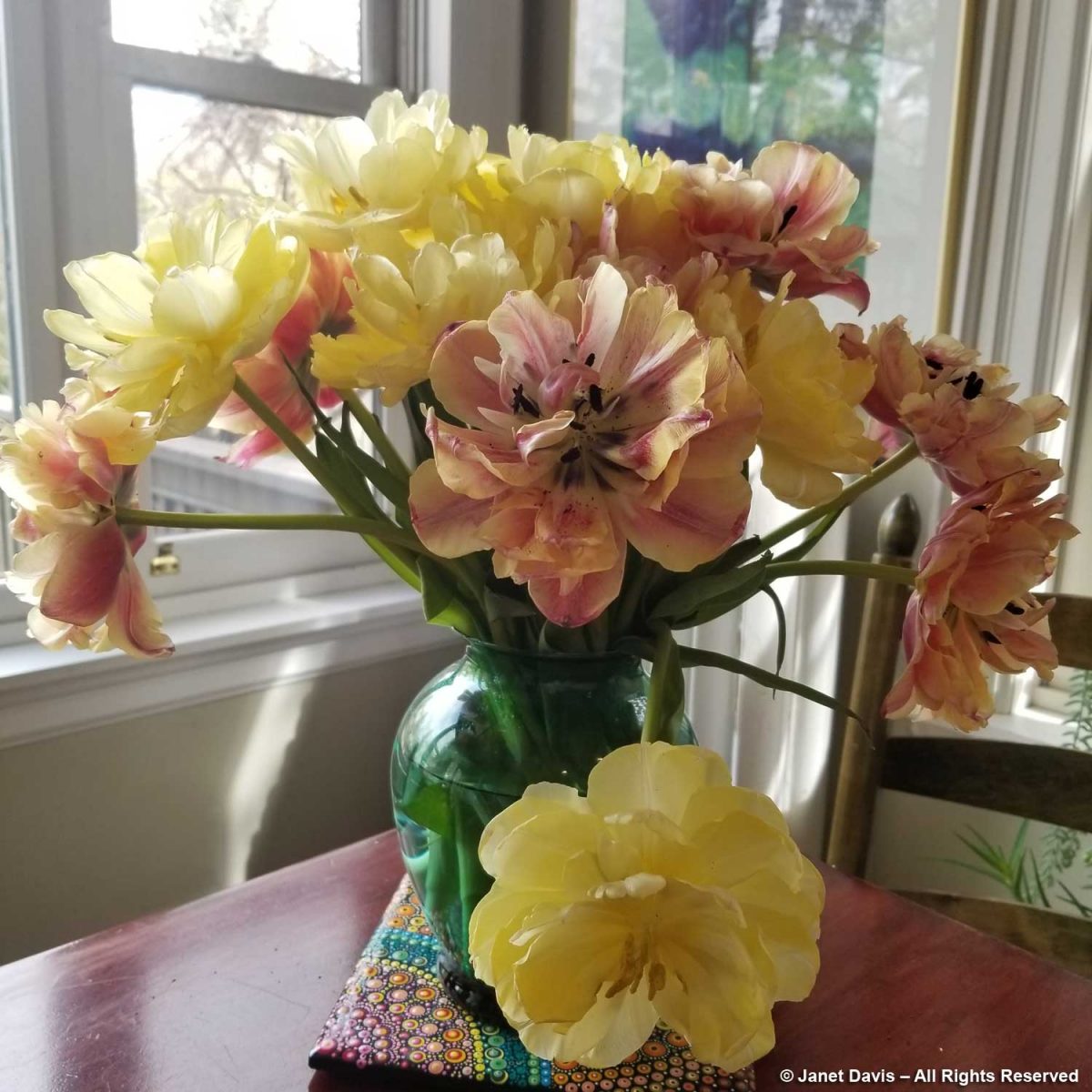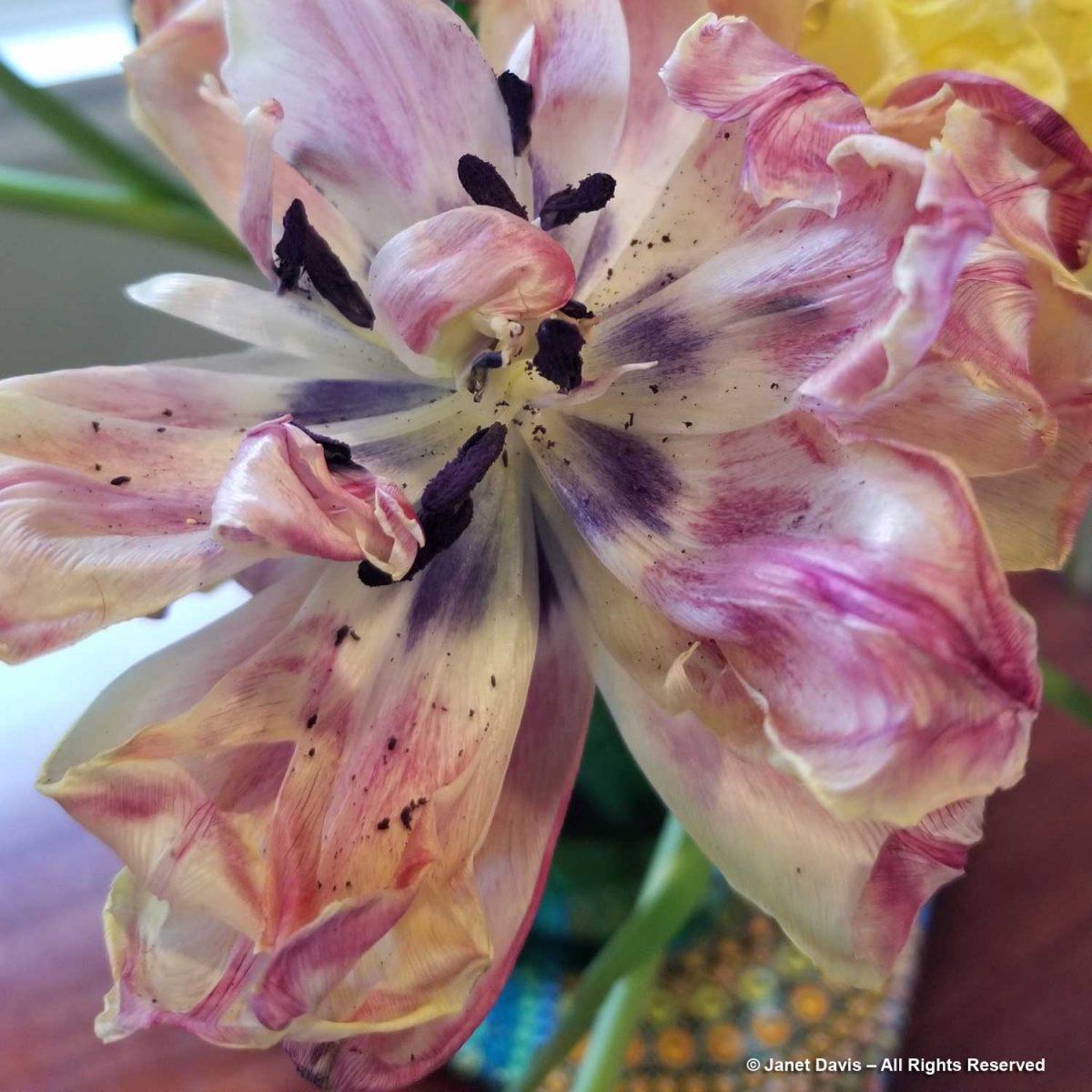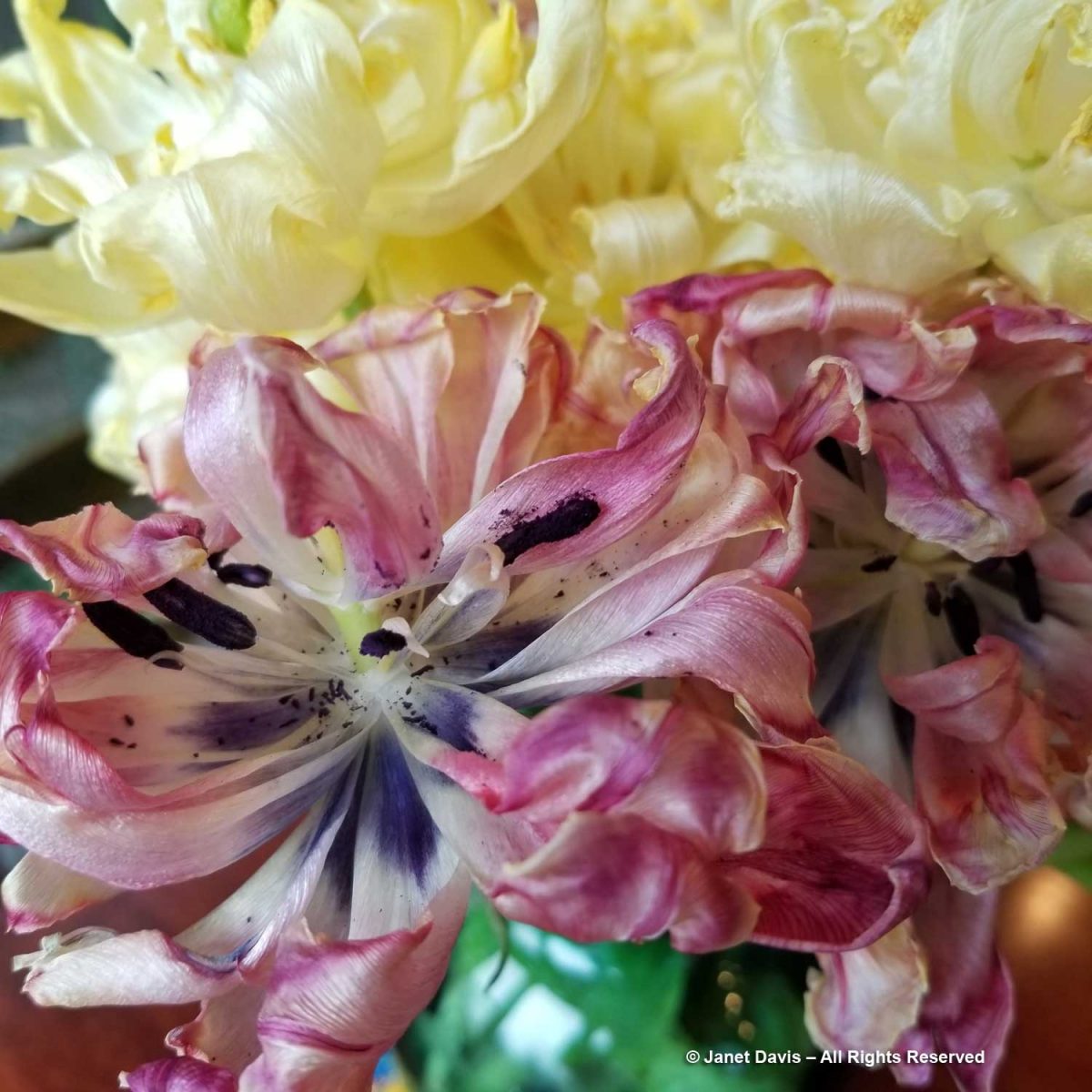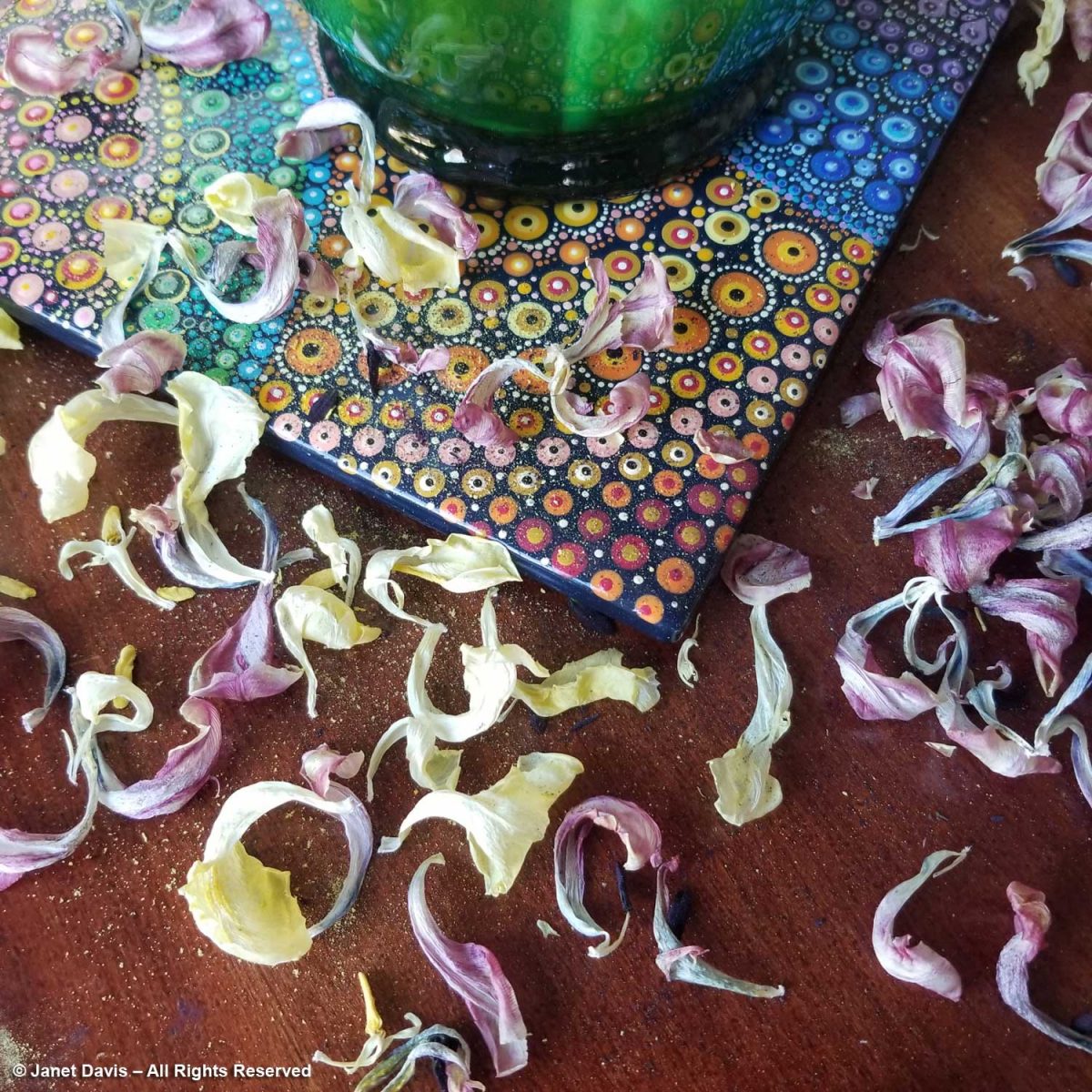According to etymology online, a “nosegay” was historically a “small bunch of flowers used to delight the sense of smell”. The word arose in the late 15th century when ‘gay’ was a noun (now obsolete) meaning ‘a gay or bright thing’. Nosegays gave rise to the tussie-mussie, a handheld bouquet in an ornate, cone-shaped, metallic vase popular in late 19th century Victorian times that became a kind of fashion accessory (plus mobile air freshener in those pre-deodorant days.) My spring nosegays are different from the summer bouquets I make at the cottage with my meadow flowers…..

…. or the bouquets I make for the living room mantel, like this one with boughs of cherry blossoms and peonies…..
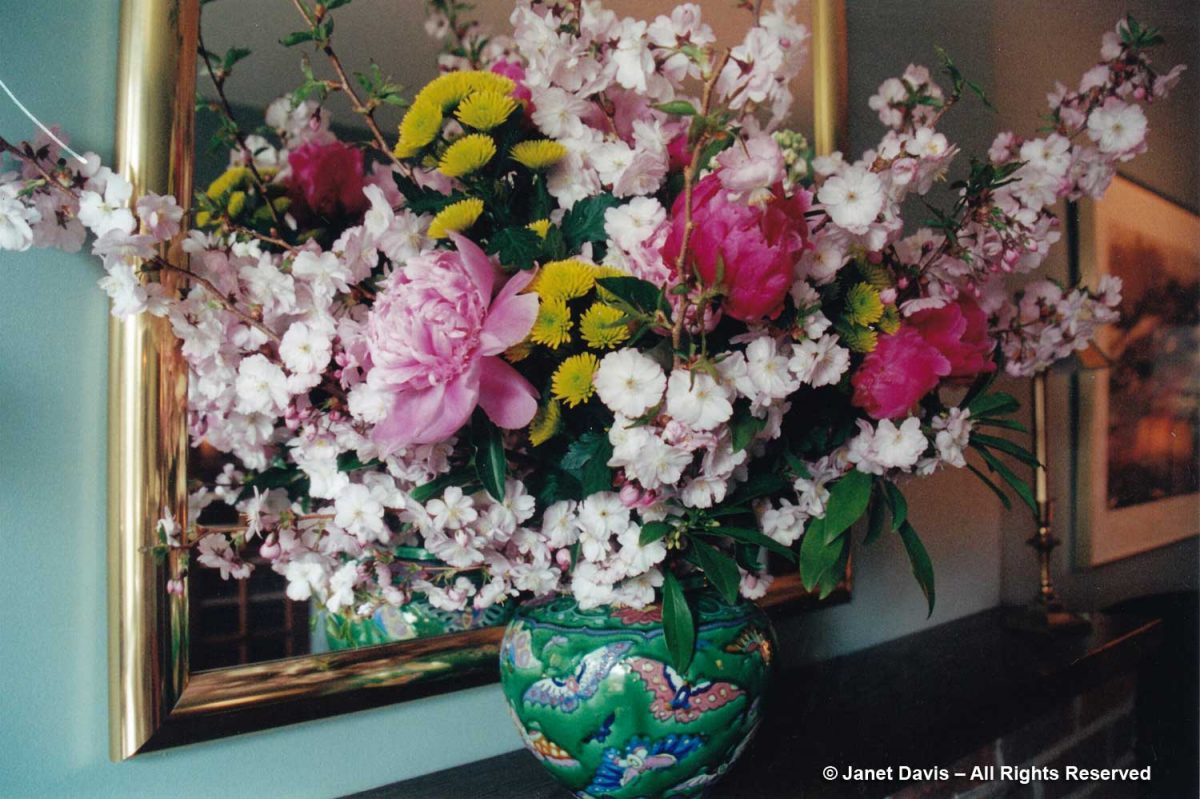
….. or the ones I’d make in hollowed out cabbages and pumpkins! This was autumn 2002.

I think of my nosegays as tiny bouquets that indeed often delight my sense of smell, especially because the spring blossoms I include are often growing too low for me to bend in order to smell their perfume. That is definitely the case with fragrant snowdrops (Galanthus nivalis), which I adorned with a small rhyme one spring after a long, snowy winter.
Snowdrops in a shot glass How apt, I think. I could get drunk in these tiny, nodding blossoms.. Savoring, after a long sober winter The first intoxicating sip of spring

Snowdrops flower very early, often persisting under spring snow, along with crocuses, Iris ‘Katharine Hodgkin’ and fragrant viburnum (V. farreri), so they make lovely companions. This tiny bouquet from March 25th this year had such a sweet scent. Speaking of ‘this year’, spring flowers emerged early, were buried in snow a few weeks later, and have enjoyed the cool temperatures, allowing them to last longer – something that doesn’t happen often in Toronto,

There is such a delicacy about these early bloomers, best appreciated up close. I photographed this on April 19, 2020.

Way back on March 20, 2012, a record warm and early spring, I needed three little vases to showcase my spring bulbs. From left we have blue and white Siberian squill (S. siberica and S. siberica ‘Alba’) with glory-of-the-snow (Scilla forbesii), Dutch hybrid crocuses (C. verna), and Greek windflower (Anemone blanda ‘Blue Shades’) with Corydalis solida ‘Beth Evans’.
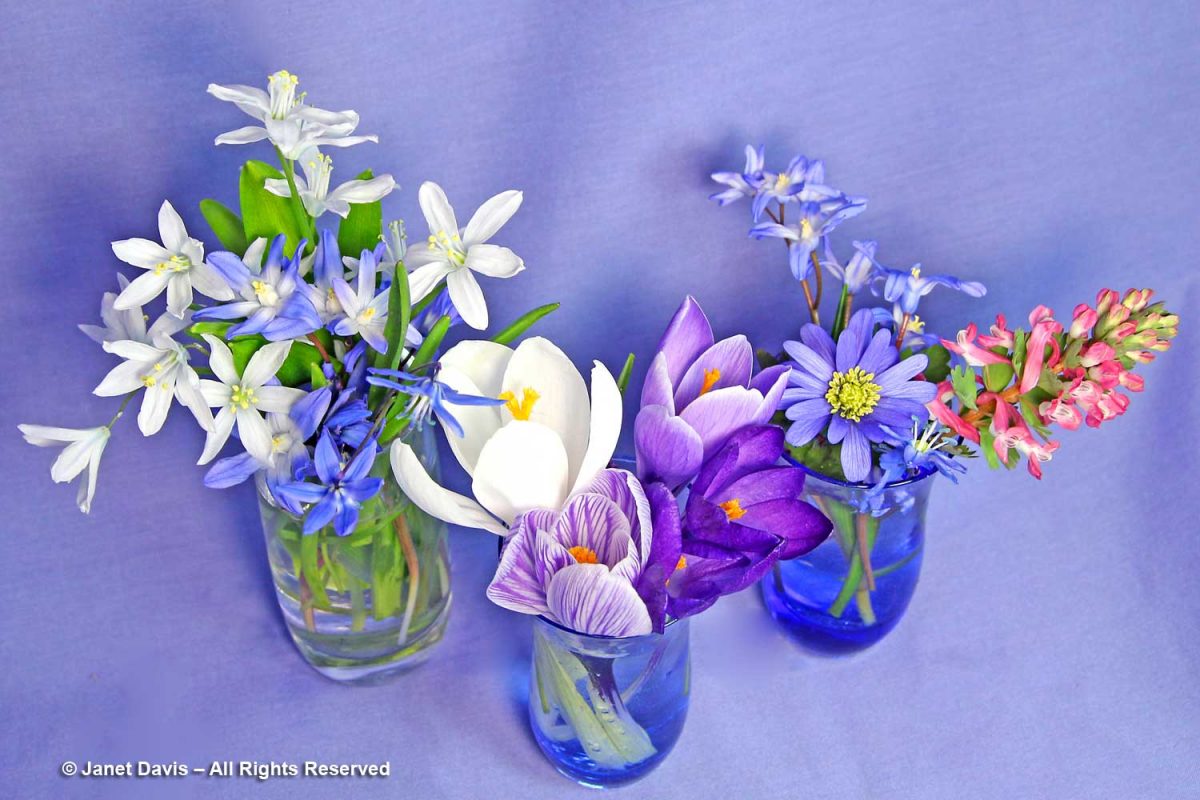
This was April 6, 2020. I liked the little dash of orange from the Crocus x luteus ‘Golden Yellow’, along with the ice blue striped squill (Puschkinia scilloides), glory-of-the-snow (Scilla forbesii), blue Siberian squill (Scilla siberica) and pink ‘Beth Evans’ corydalis (C. solida).
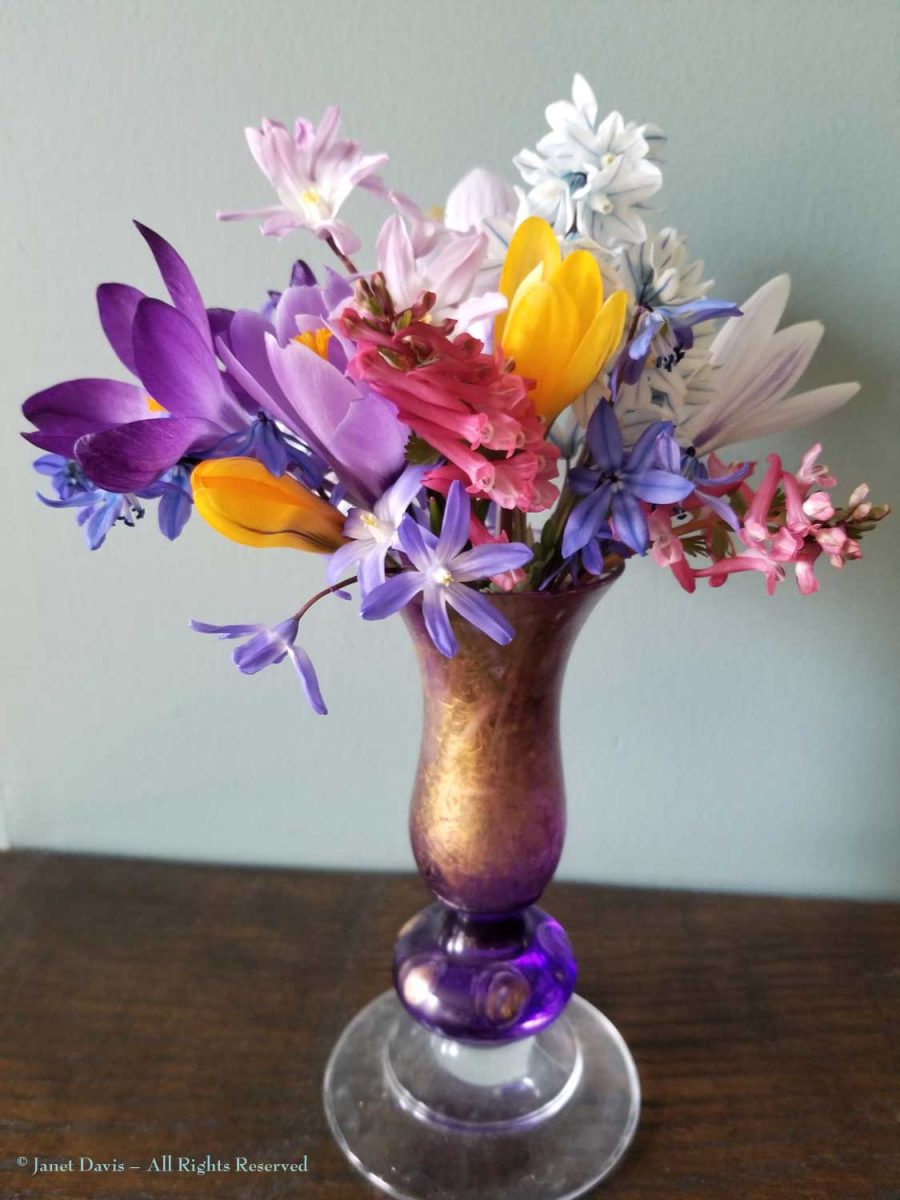
When the Dutch crocuses are at their prime, sometimes it’s fun just to showcase those silken purple petals. This was from April 12, 2014.
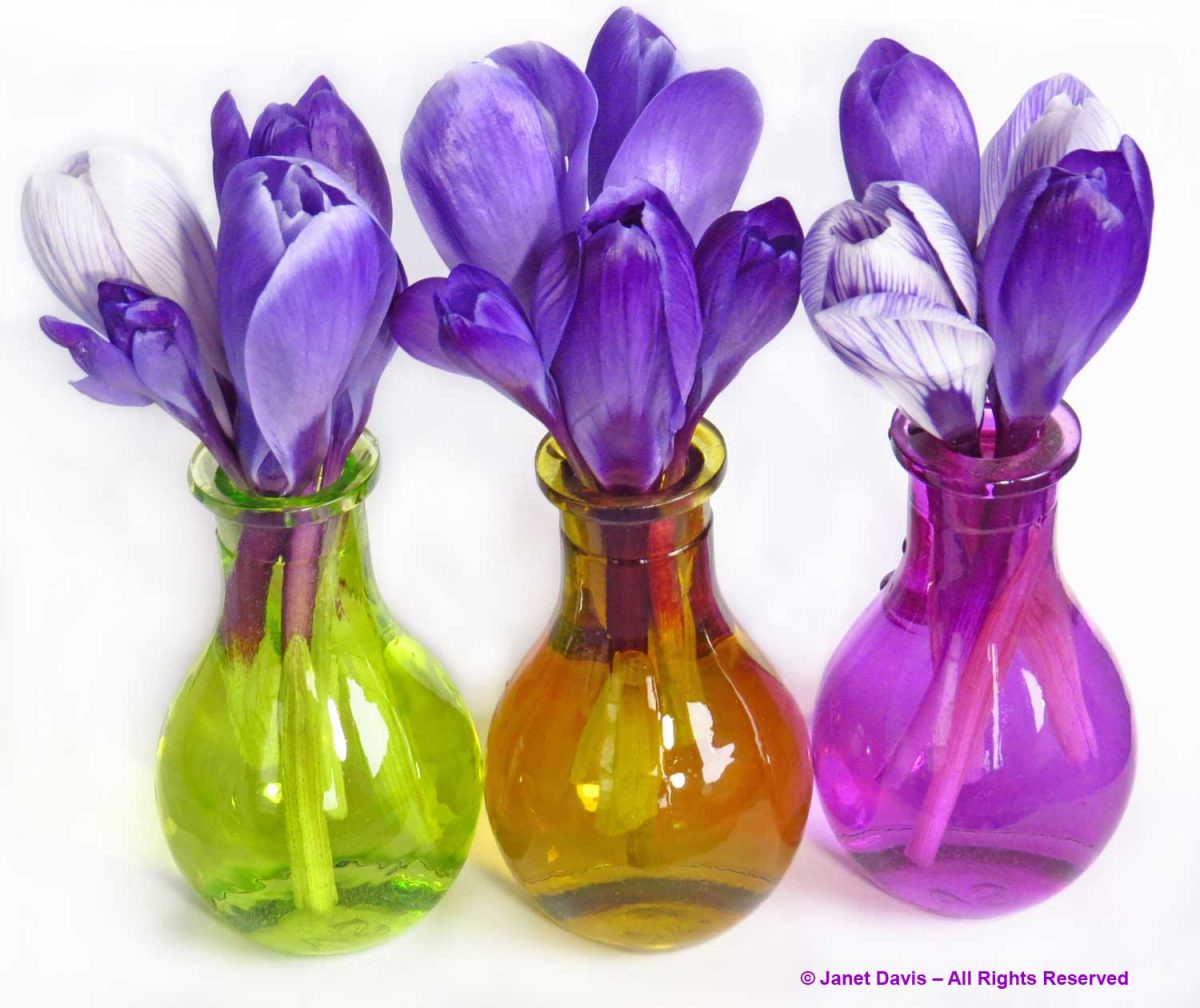
Similarly, I sometimes like to pick just one perfect spring bloom, like this Anemone blanda ‘Blue Shades’ on April 9, 2012, and give it the spotlight.
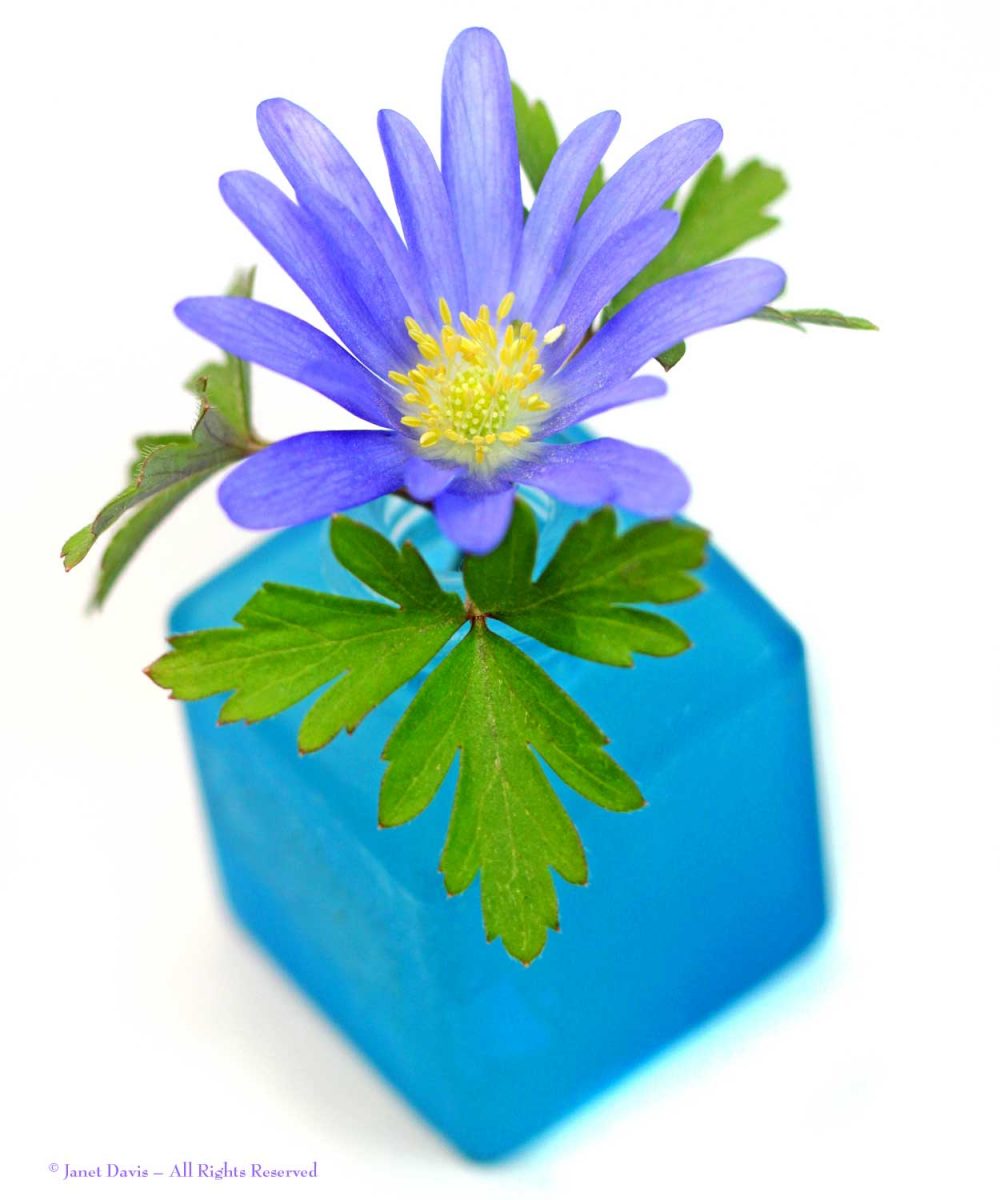
On April 23, 2013, I selected just a few stems of ‘Violet Beauty’ glory-of-the-snow (Scilla forbesii) to photograph. Interestingly, this cultivar has not persisted in my garden, unlike the parent species.

We have a set of antique crystal shot glasses just the right size for a nosegay of spring bulbs. This was April 18, 2019, and featured the usual suspects.

Pastels flowering at the same time, on April 10, 2020, included light pink Viburnum farreri (which I blogged about recently), pink Corydalis solida ‘Beth Evans’ and ice-blue striped squill (Puschkinia scilloides).
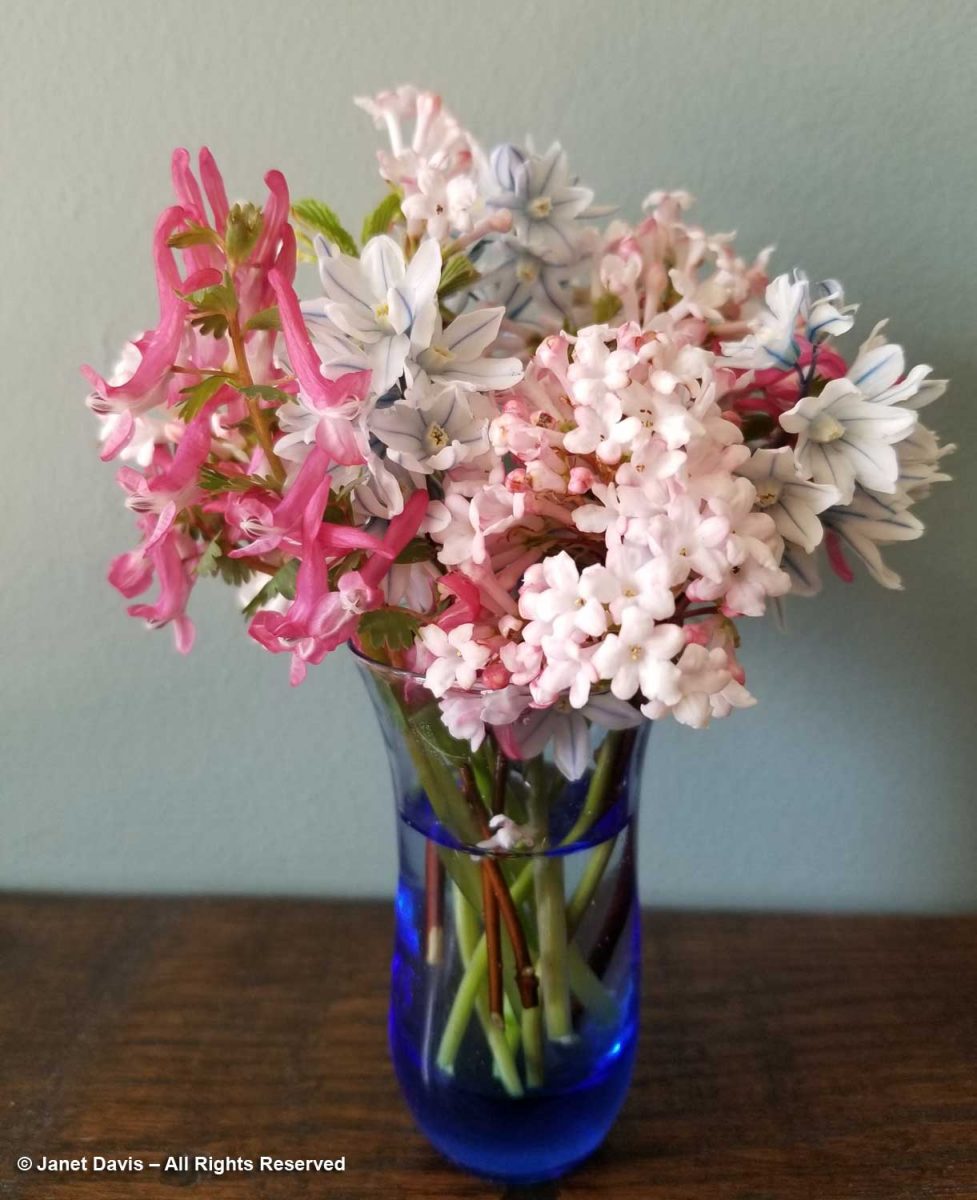
These two little bulbs grow together in my garden and look just as lovely in a votive candle holder. Blue Siberian squill (Scilla siberica) and Corydalis solida ‘Beth Evans’. These would normally be finished by now, but our cool 2021 spring kept them in good shape for my April 25th photo.
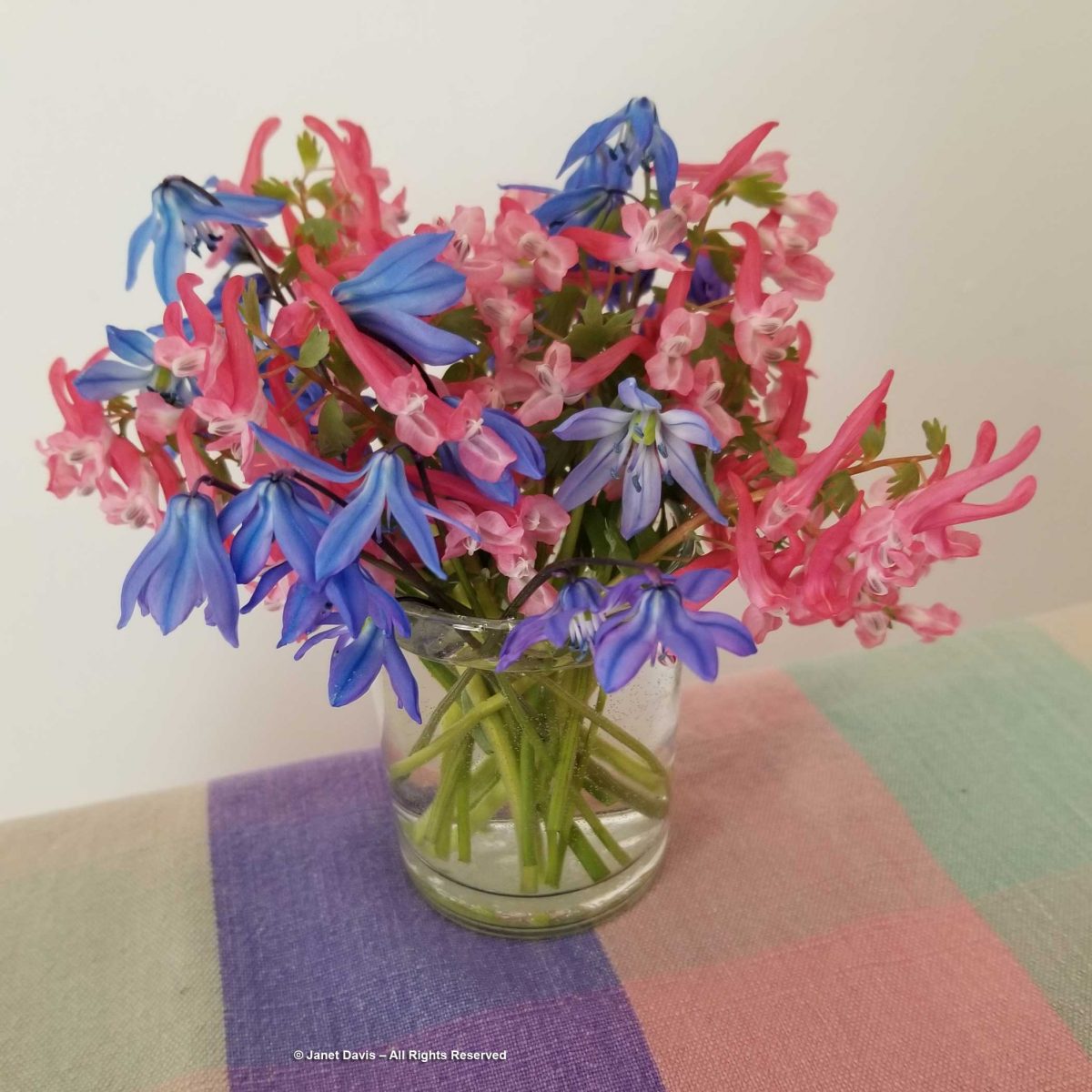
I adore grape hyacinths and wanted an early one in sky-blue. So last autumn I planted loads of Muscari aucheri ‘Ocean Blue’ and I am delighted. They’re at the front of this little nosegay, along with pure-white Narcissus ‘Thalia’, broad-leaved grape hyacinth (Muscari latifolium) with its navy-and-royal blue florets and Anemone blanda ‘Blue Shades’.

Last April 29th, I combined Muscari latifolium with the wonderful Tulipa praestans ‘Shogun’ and Anemone blanda ‘Blue Shades’.

Last week I plucked just a few flowers from my garden to place in my green Irish mug. Included were three daffodils, ‘Thalia’, ‘Stainless’ and little ‘Golden Echo’, which has become such a favourite that I wrote a blog in its honour. As well, I added a stem of peachy-orange Hyacinthus ‘Gipsy Queen’ which wafted its scent in my kitchen. Behind are two tulips, T. fosteriana ‘Orange Emperor’, left, and T. praestans ‘Shogun’, right.

This little nosegay had a bit of everything! It was May 4, 2020, so I was able to partner white Narcissus ‘Thalia’ with (clockwise from front) a sprig of blue Siberian bugloss (Brunnera macrophylla) with a stem of magenta Rhododendron ‘PJM’ right behind it; lilac-purple Corydalis solida; Anemone blanda ‘Blue Shades’; broad-leaved grape hyacinth (Muscari latifolium); and wine-purple snakeshead fritillary (Fritillaria meleagris) at right.

I love bright, sunny colours and this little nosegay in a bud vase brightened up my kitchen on May 13, 2020. Along with spice-scented Narcissus ‘Geranium’, front, I used the orange, lily-flowered tulip ‘Ballerina’; Narcissus ‘Golden Echo’ (which lasts a long time because of its sequential blooming); and a few sprigs of forget-me-not (Myosotis sylvatica) and forsythia.

As May arrives, other parts of my garden wake up. Spring 2019 was quite cool, so the Greek windflowers (Anemone blanda ‘Blue Shades’) and Corydalis solida were still in flower when my masses of forget-me-nots (Myosotis sylvatica) started flowering. I celebrated these “little blue flowers” on May 22, 2019, including common grape hyacinth (Muscari armeniacum) and Siberian bugloss (Brunnera macrophylla).

One of my biggest garden problems here at home in Toronto is the steady advance of lily-of-the-valley (Convallaria majalis) through plantings. In my case, it was here when we bought our old house 38 years ago and my mistake, had I known what was coming, was not to eradicate it immediately. Now it is the tough groundcover for most of my front garden and a lot of the back. Fortunately, it doesn’t seem to deter the native, prairie perennials that emerge through it for summer. I have had fun with lily-of-the valley, turning it into a fragrant chapeau for a garden party, which I detailed in a blog. And I also add a few stems to whatever is in bloom, including grape hyacinths, Siberian bugloss and forget-me-nots, like the nosegay below from May 22, 2020.

My lawn contains lots of native Confederate violet (Viola sororia var. priceana) and I’ve included them in the odd nosegay with forget-me-nots and grape hyacinths. This was April 22nd in the record-warm spring of 2012.

In my final photo, made May 23, 2020, I’ve used the green shot glasses and flask from a vintage ‘gentleman’s travelling bar set’ that my late father-in-law gave my husband. Rather than whiskey, it includes the first perfumed blossoms of Burkwood’s viburnum (V. x burkwoodii) along with blue camassia (C. leichtlinii ‘Caerulea’), the final flowers of Narcissus ‘Golden Echo’, lily-of-the-valley, and common grape hyacinths (Muscari armeniacum). And that’s a wrap for my spring nosegays!



